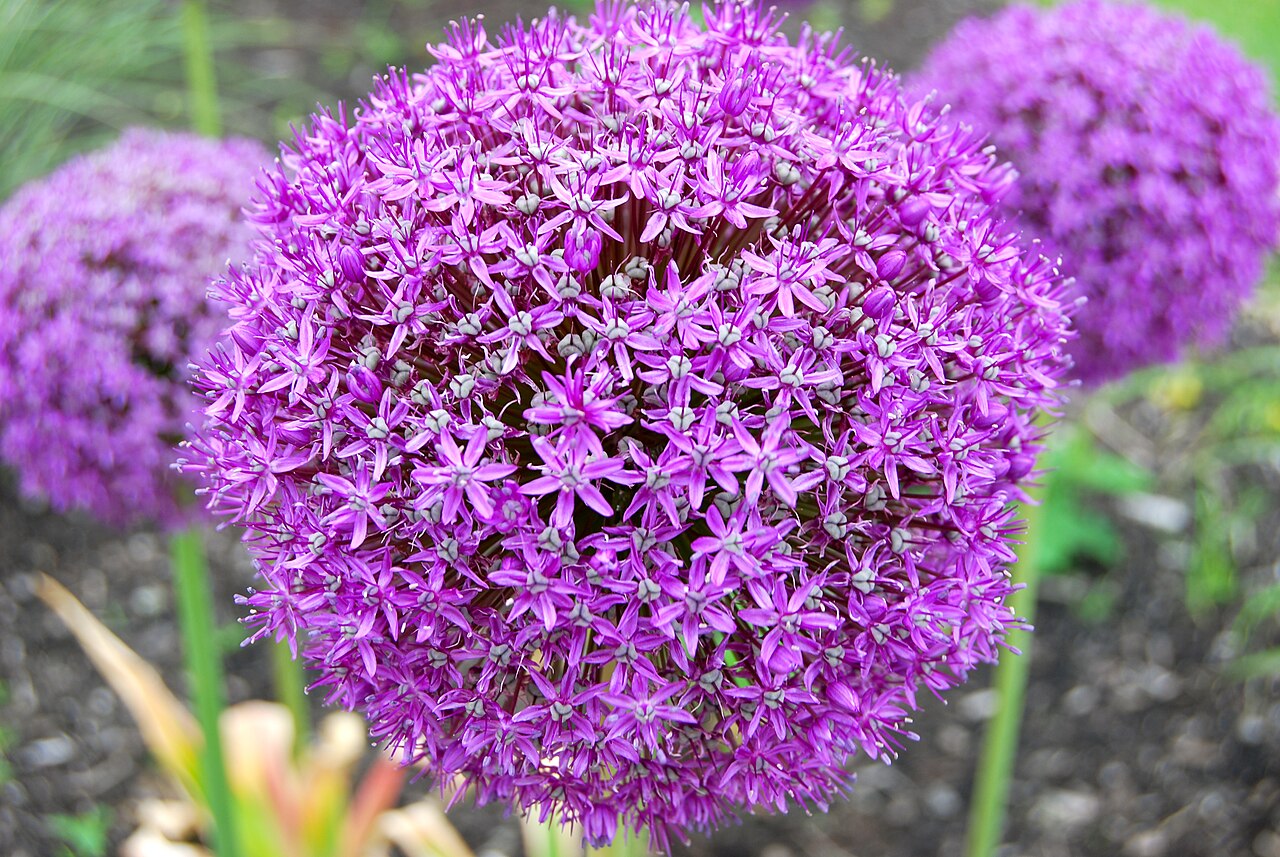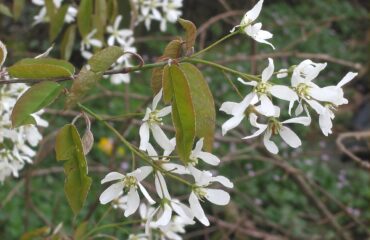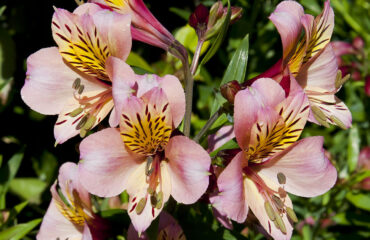Allium giganteum, commonly known as Giant Allium or Giant Onion, is a striking perennial plant in the Amaryllidaceae family. Native to Central and Southwestern Asia, it is renowned for its tall, sturdy stems topped with large, spherical clusters of tiny, star-shaped purple flowers. These globular flower heads can reach up to 6 inches (15 cm) in diameter and are a stunning feature in garden landscapes, attracting bees and butterflies. The plant’s narrow, strap-like leaves emerge in spring and typically wither by the time the flowers bloom in early to mid-summer.
Preferred Growing Conditions:
- Soil Type: Prefers well-drained, sandy or loamy soil; thrives in soil enriched with organic matter.
- Sunlight: Requires full sun; needs at least 6 hours of direct sunlight daily for optimal growth and flowering.
- Temperature: Hardy in USDA zones 5-9; prefers temperate climates and can tolerate light frost.
- Water Needs: Moderate; requires regular watering during the growing season but can tolerate short periods of drought once established.
Allium Giganteum (Giant Allium) Propagation Methods:
1. Seed Propagation:
Growing Allium giganteum from seeds is a viable method, although it requires patience as the plants take several years to mature and flower.
- Seed Collection and Preparation:
- Collect seeds from mature flower heads once the seed capsules have dried and turned brown.
- Gently crush the capsules to release the small, black seeds.
- Clean and dry the seeds for a few days before planting or store them in a cool, dry place for spring planting.
- Sowing Techniques:
- Fill seed trays or small pots with a light, well-draining seed-starting mix.
- Sow the seeds on the surface of the soil and cover lightly with a thin layer of soil or sand.
- Keep the soil consistently moist but not waterlogged.
- Place the trays in a bright location with temperatures around 60-70°F (15-21°C).
- Germination Requirements:
- Seeds typically germinate within 4-6 weeks under optimal conditions, but germination can be erratic and may take longer.
- Provide consistent moisture and protection from direct sunlight during germination.
- Once seedlings emerge, keep the soil moist and provide bright, indirect light.
- Care for Seedlings:
- When seedlings have developed several true leaves and are sturdy enough to handle, transplant them into individual pots or directly into the garden.
- Choose a location with similar growing conditions to the parent plant, such as a sunny area with well-drained soil.
- Note that seedlings grown from seeds may take 3-4 years to reach maturity and flower.
2. Bulb Division:
Division of bulbs is the most common and effective method for propagating Allium giganteum, particularly for maintaining the characteristics of the parent plant.
- Timing:
- The best time for bulb division is in autumn after the foliage has died back or in early spring before new growth begins.
- Method:
- Carefully dig up the entire clump of bulbs, being cautious not to damage the bulbs or their roots.
- Shake off excess soil to expose the bulbs.
- Separate the bulbs, ensuring each division has a healthy bulb with roots attached. Small offset bulbs can also be separated for planting.
- Replanting:
- Replant the divided bulbs immediately in prepared soil enriched with compost or organic matter.
- Plant bulbs at a depth of about 6-8 inches (15-20 cm) and space them 12-18 inches (30-45 cm) apart to allow room for growth.
- Water thoroughly to settle the soil around the bulbs.
- Care After Division:
- Keep the newly planted bulbs well-watered as they establish.
- Mulch around the base to retain soil moisture and regulate temperature.
- Protect from strong winds and harsh sunlight during the initial recovery period.
3. Offsets:
Allium giganteum often produces small offset bulbs at the base of the parent bulb. These can be used to propagate new plants.
- Collection and Preparation:
- Collect offsets during the dormant season in late autumn or early winter.
- Gently separate them from the parent bulb, ensuring they have a portion of the root system attached.
- Planting:
- Plant the offsets in small pots filled with a well-draining potting mix or directly in the garden in a suitable location.
- Place them at a depth similar to the parent bulbs and water lightly to settle the soil.
- Rooting and Growth:
- Offsets will develop roots and shoots over several weeks to months.
- Maintain consistent moisture and provide protection from extreme weather until they establish and begin to grow.
- Offsets may take a few years to reach flowering size.
4. Tissue Culture:
Tissue culture is an advanced propagation method used primarily in commercial settings to produce large numbers of uniform plants quickly. This method involves growing plant tissues in a sterile, controlled environment.
- Process:
- Small pieces of plant tissue, typically from the growing tips or meristem, are sterilized and placed in a nutrient-rich, sterile medium.
- Under controlled conditions, the tissue forms a callus, which then differentiates into shoots and roots.
- Once the plantlets are large enough, they are transferred to soil or a suitable growing medium to acclimate to normal growing conditions.
- Advantages:
- Produces a large number of uniform plants quickly.
- Can propagate disease-free plants and maintain rare or desired characteristics.
Care for Newly Propagated Plants:
- Ensure new plants are placed in a location with full sun and well-draining soil.
- Water regularly during the growing season, especially in the first few years after planting.
- Protect young plants from pests and diseases, and provide support if needed to prevent wind damage.
- Apply a balanced, slow-release fertilizer in early spring to encourage healthy growth and flowering.
Common Challenges and Solutions:
- Bulb Rot: Ensure good drainage and avoid waterlogging, especially during the dormant season.
- Pests: Monitor for common pests such as aphids and allium leaf miners. Treat infestations with appropriate insecticides or natural predators.
- Fungal Diseases: Prevent fungal infections by ensuring good air circulation and avoiding overhead watering. Use fungicides as needed.
Additional Tips:
- Mulch around the base of the plants to retain moisture and suppress weeds.
- Remove spent flower heads to encourage bulb growth and prevent seed formation.
- Plant in clusters or groups for a more dramatic display of blooms.
- Giant Alliums make excellent companions for other sun-loving perennials, such as daylilies, salvia, and ornamental grasses.
Propagating Allium giganteum offers a rewarding opportunity to add these impressive and architectural plants to your garden. Whether you choose to start from seeds, divide bulbs, or propagate offsets, with proper care and attention, Giant Alliums will thrive and become a stunning focal point in your landscape.
Share this article



